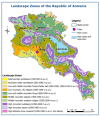Traditionally Used Medicinal Plants of Armenia
- PMID: 39683204
- PMCID: PMC11644142
- DOI: 10.3390/plants13233411
Traditionally Used Medicinal Plants of Armenia
Abstract
The rich and diverse flora of Armenia has been used for medicinal purposes for at least 3000 years. The relevant literature in Armenian, English, and Russian revealed a vast array of used medicinal plants, some of them unique to the Caucasus region. The usage of medicinal plants confirms the position of Armenia as a country at the crossroads of Asia and Europe because of its traditional usage of medicinal plants from both continents. Literature data in Armenian, English, and Russian on medicinal plants of Armenia were mainly obtained using various electronic databases. From all available sources, 320 Armenian medicinal plant species were extracted with their botanical and local names and traditional uses. The use of medicinal plants by the Armenian people is systematically compiled, including the used plant organs and preparations and the ailments for which the various taxa are/were used. Medicinal plants of Armenia are represented for both wild and cultivated species. Some of the taxa used are unique to Armenia or the Caucasus region, while many other species are also used in various other countries. Some of the species from traditional Armenian medicine are currently being studied using modern methods.
Keywords: Armenia; Caucasus; ethnopharmacology; medicinal plants; traditional medicine.
Conflict of interest statement
The authors declare no conflicts of interest.
Figures





Similar articles
-
Wild plants and fungi sold in the markets of Yerevan (Armenia).J Ethnobiol Ethnomed. 2020 May 19;16(1):26. doi: 10.1186/s13002-020-00375-3. J Ethnobiol Ethnomed. 2020. PMID: 32429968 Free PMC article.
-
Bridging past and present: exploring Cannabis traditions in Armenia through ethnobotanical interviews and bibliographic prospecting.J Cannabis Res. 2025 Jan 30;7(1):8. doi: 10.1186/s42238-025-00259-x. J Cannabis Res. 2025. PMID: 39881377 Free PMC article.
-
Antimicrobial activity of some plant materials used in Armenian traditional medicine.BMC Complement Altern Med. 2017 Jan 17;17(1):50. doi: 10.1186/s12906-017-1573-y. BMC Complement Altern Med. 2017. PMID: 28095835 Free PMC article.
-
Medicinal plants from the genus Acalypha (Euphorbiaceae)--a review of their ethnopharmacology and phytochemistry.J Ethnopharmacol. 2015 Jan 15;159:137-57. doi: 10.1016/j.jep.2014.10.040. Epub 2014 Oct 30. J Ethnopharmacol. 2015. PMID: 25446604 Review.
-
An overview on ethnobotanico-pharmacological studies carried out in Morocco, from 1991 to 2015: Systematic review (part 1).J Ethnopharmacol. 2021 Mar 1;267:113200. doi: 10.1016/j.jep.2020.113200. Epub 2020 Aug 1. J Ethnopharmacol. 2021. PMID: 32750461
Cited by
-
Reviving the past for a healthier future: ancient molecules and remedies as a solution to the antibiotic crisis.Future Microbiol. 2025 Apr;20(5):429-441. doi: 10.1080/17460913.2025.2476290. Epub 2025 Mar 18. Future Microbiol. 2025. PMID: 40099865 Free PMC article. Review.
References
-
- Bianchini S., Raspini F., Ciampalini A., Lagomarsino D., Bianchi M., Bellotti F., Casagli N. Mapping landslide phenomena in landlocked developing countries by means of satellite remote sensing data: The case of Dilijan (Armenia) area. Geomat. Nat. Hazards Risk. 2017;8:225–241. doi: 10.1080/19475705.2016.1189459. - DOI
-
- Fayvush G., Aleksanyan A., Bussmann R.W. Ethnobotany of the Caucasus. Springer International Publishing; New York, NY, USA: 2017. Ethnobotany of the Caucasus–Armenia; pp. 21–36. - DOI
-
- UNDP (United Nations Development Programme) Human Development Report 2019: Beyond Income, Beyond Averages, Beyond Today: Inequalities in Human Development in the 21st Century. UNDP; New York, NY, USA: 2019.
-
- Krikorian M.K. Armenians in the Service of the Ottoman Empire. Routledge; Oxfordshire, UK: 2018. pp. 1860–1908.
-
- Robles M., Peyron O., Brugiapaglia E., Ménot G., Dugerdil L., Ollivier V., Ansanay-Alex S., Develle A.-L., Tozalakyan P., Meliksetian K., et al. Impact of climate changes on vegetation and human societies during the Holocene in the South Caucasus (Vanevan, Armenia): A multiproxy approach including pollen, NPPs and brGDGTs. Quat. Sci. Rev. 2022;277:107–162. doi: 10.1016/j.quascirev.2021.107297. - DOI
Publication types
LinkOut - more resources
Full Text Sources

